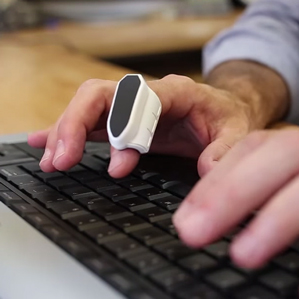Feeling More Amateur Than Maestro with a Finger-Worn Mouse
When I first heard about the Mycestro, a little computer mouse you wear on your index finger and control by wagging your digits like a symphony conductor, I laughed. It seemed very awkward.

Then I started thinking about how much time I spend using a traditional computer mouse each day, and got to thinking that it might not be such a bad idea to mix up my mouse routine. Maybe it would make some tasks more efficient, or lessen the strain I feel in my shoulders after hours in front of a computer. And perhaps it would be easier to use than other gesture control devices, such as Leap Motion, which sits on your desk and senses different hand gestures. The device, called Mycestro (pronounced “maestro”), started as a Kickstarter project in 2013 and is now selling online for $149.
I spent several days using the device, for a few hours at a time. I used it to control all kinds of activities: watching videos, listening to music, playing games, researching stories, sending e-mail, and typing up this review.
For me, the Mycestro ranged from frustratingly useless to surprisingly effortless. At first, I spent a lot of time feeling like an oaf and not a maestro, struggling to get the cursor to go precisely where I wanted it. Yet, slowly, I began to get used to this strange new world of “finger-mousing.” I never got fully comfortable with the device, though; it was just too awkward and, at times, uncomfortable.
After more than two decades of using a mouse that sits under your hand, it’s hard to get used to one that clings to your finger. The Mycestro is like a bulky, futuristic ring: it’s about 4.5 centimeters long, and looks sort of like an arrowhead sitting on your index finger (only the right one, for now). The side closest to your thumb includes a touchpad and three little buttons for scrolling, selecting, and clicking.
To use the Mycestro, you plug a little Bluetooth dongle that comes with it into a USB port on your computer. Then you slide the ring on, touch your thumb anywhere on its side touchpad, and start waving your hand to see the cursor move.
At first, it’s exciting—you’re moving your hand left to right, up and down, diagonally, sweeping it in an arc in front of you, and the Mycestro responds immediately, interpreting your gestures as on-screen cursor movements. There was rarely any lag, and the company that makes it, Innovative Devices, says it should work at a distance of up to 30 feet.
Though the Mycestro only weighs half an ounce, it started to feel heavy and clunky really quickly. Wearing it for more than half an hour or so at a time while typing was a challenge. I could never comfortably type with my index finger while it was wrapped around my finger.
Overall, I can see Mycestro’s utility while traveling if you hate using a trackpad and don’t have room for a regular mouse, or while taking a break from sitting in front of a desk. But unless somebody yanks my trusty work mouse out from under my hand, the Mycestro won’t fully replace it.
Keep Reading
Most Popular
Large language models can do jaw-dropping things. But nobody knows exactly why.
And that's a problem. Figuring it out is one of the biggest scientific puzzles of our time and a crucial step towards controlling more powerful future models.
The problem with plug-in hybrids? Their drivers.
Plug-in hybrids are often sold as a transition to EVs, but new data from Europe shows we’re still underestimating the emissions they produce.
Google DeepMind’s new generative model makes Super Mario–like games from scratch
Genie learns how to control games by watching hours and hours of video. It could help train next-gen robots too.
How scientists traced a mysterious covid case back to six toilets
When wastewater surveillance turns into a hunt for a single infected individual, the ethics get tricky.
Stay connected
Get the latest updates from
MIT Technology Review
Discover special offers, top stories, upcoming events, and more.